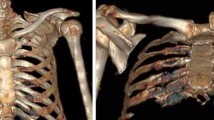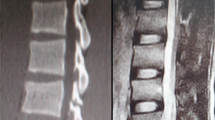Abstract
Manubriosternal dislocation is an extremely rare occurrence, especially as the result of an indirect compression injury. Manubriosternal dislocations are divided into two types: In a Type I dislocation, the body of the sternum is displaced in a dorsal direction; in Type II dislocation, the body is displaced to the ventral side of the manubrium. A manubriosternal dislocation may be caused by direct or indirect trauma. Direct injury is generally a collision injury occurring in the context of a road accident. Resulting may be in either a Type I or Type II dislocation. Indirect trauma always leads to a Type II dislocation due to a flexion-compression mechanism in the region of the spine. Rheumatic arthritis and obvious kyphosis are predisposing factors in manubriosternal dislocation due to the indirect compression injury. Non-operative treatments after reduction, e.g. correction tape or plaster bandage, symptomatic pain treatment, application of ice, and several weeks without sports, are associated with a not inconsiderable rate of subluxations or reluxations, especially due to insufficient patient compliance. These disorders can lead to chronic pain, periarticular calcification with ankylosis, and progressive deformity. It has not been possible to establish an optimal, standardized operative procedure so far because of the small number of cases. We have achieved very good, postoperative long-term outcomes after plate osteosynthesis of manubriosternal dislocations in two patients.








Similar content being viewed by others
References
Birnsingl MA (1976) Injuries to the chest and abdomen In: Wilson JN (eds) Fractures and joint injuries, 5th edn. Churchill Livingston, London, p 169
Bordon LM (1989) Dislocation of the manubriosternal joint: the role of the second chondrosternal joint, and stabilisation by surgical fusion. Cent Afr J Med 35:464–468
Cameron HU (1980) Traumatic disruption of the manubriosternal joint in the absence of rib fractures. J Trauma 20:892–894
Cooper KL (1988) Insufficiency fractures of the sternum: a consequence of thoracic kyphosis? Radiol 167:471–472
De Palma AF (1970) The management of fractures and dislocations. Saunders, Philadelphia, p 475
Fowler AW (1957) Flexion-compression injury of the sternum. J Bone Joint Surg 39B:487–497
Gopalakrishnan KC, El Masri WS (1986) Fractures of the sternum associated with spinal injury. J Bone Joint Surg 68B:178–181
Helal B (1964) Fracture of the manubrium sterni. J Bone Joint Surg 46B:602–607
Henley MB, Peter RE, Benirschke SK (1991) External fixation of the sternum for thoracic trauma. J Orthop Trauma 5:493–497
Hills MW, Delprado AM, Deane SA (1993) Sternal fractures: associated injuries and management. J Trauma 35:55–60
Holt ME, Rooney PJ (1980) Manubriosternal joint subluxation in rheumatoid arthritis. J Rheumatol 7:260–262
Jenyo MS (1985) Post traumatic fracture-dislocation of manubriosternal joint with a wedge fracture of the body of the fourth thoracic vertebra. J Trauma 25:274–275
Kelly MC, Hopkinson ND, Zaphiropoulos GC (1986) Manubriosternal joint dislocation in rheumatoid arthrithis: the role of thoracic kyphosis. Ann Rheum Dis 45:345–348
Kurtzweg FT, Danna SJ, Lolley RT (1972) Open reduction and fixation of a comminuted fracture of the sternum. J Thorac Cardiovasc Surg 63:424–426
Leitenen H, Saksanen S, Suoranta H (1970) Involvement of the manubriosternal articulation in rheumatoid arthritis. Acta Rheumatol Scand 16:40–46
Park WM, McCall IW, McSweeney T (1980) Cevicodorsal injury presenting as sternal fracture. Clin Radiol 31:49–53
Rapoport RJ, Carrera GF, Kozin F (1979) Manubrio-sternal joint subluxation in rheumatoid arthritis. J Rheumatol 6:174–177
Savill DL (1951) The manubriosternal joint in ankylosing spondylitis. J Bone Joint Surg 33B:56–64
Scher AT (1983) Associated sternal and spinal fractures. S Afr Med J 64:98–100
Schwagten V, Beuacourt L, Van Schil P (1994) Traumatic manubriosternal joint disruption: case report. J Trauma 36: 747–748
Scudamore CH, Ashmore PG (1982) Spontaneous sternal segment dislocation: a case report. J Pediatr Surg 17:61–63
Stahlman GC, Wyrsch RB, McNamara MJ (1995) Late-onset sternomanubrial dislocatin with progressive kyphotic deformity after a thoracic burst fracture. J Orthop Trauma 9:350–353
Thirupathi R, Husted C (1982) Traumatic disruption of the manubriosternal joint: a case report. Bull Hosp Joint Dis Orthop Inst 42:242–247
Watanabe S, Nakamura T, Shimizu Y (1989) Traumatic sternal segment dislocation in a child. Chest 96:684–686
Wiseman MJ (1980) Dislocation of the manubriosternal joint in rheumatoid arthritis. Ann Rheum Dis 40:307–308
Woo CC (1989) Traumatic manubriosternal joint subluxations in two basketball players. J Manipulative Physiol Ther 11:433–437
Author information
Authors and Affiliations
Corresponding author
Rights and permissions
About this article
Cite this article
Kälicke, T., Frangen, T.M., Müller, E.J. et al. Traumatic manubriosternal dislocation. Arch Orthop Trauma Surg 126, 411–416 (2006). https://doi.org/10.1007/s00402-006-0145-2
Received:
Published:
Issue Date:
DOI: https://doi.org/10.1007/s00402-006-0145-2




